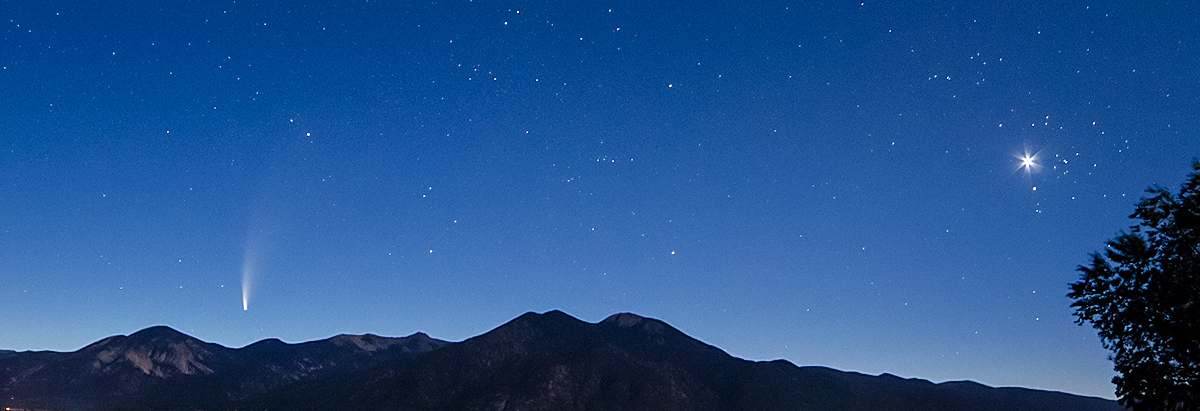
Welcome to taosastronomer.com!
offering
local "hands-on" observing
(visual and imaging) sessions and instruction
viewing and imaging from Rabbit Valley Observatory
a dark sky location on the mesa just west of Taos, NM
Heart and Soul Nebulae in Cassiopeia and Double Cluster in Perseus -- informational page |
First of all, it is important (!) to actually visually locate these objects in the sky. As can be seen by the above charts provided by freestarcharts.com which also provides much general information; there are many DSO's (Deep Sky Objects) of interest in the Milky Way laden constellations of Cassiopeia and Perseus. Further, the Double Cluster in Perseus is visible to the naked eye under reasonably dark skies. Click on the links and charts above to learn more about both constellations and many of the Deep Sky Objects they contain. Below is a wide-field photograph of the area, with several of the nebulae and clusters, including the Heart (IC1805) and the Double Cluster (NGC884 and NGC889) as well as many more. Compare this very low-powered "naked-eye" view with my thumbnails just below.
|
credit of above chart -- "Constellation of the Month"
Note that visible in the above chart are NGC884 and NGC869 (The Double Cluster in Perseus) as well as IC1805 (The Heart Nebula in Cassiopeia) and IC1848 (The Soul Nebula in Cassiopeia) -- below are my larger-scale images of these objects -- also seen and locatable are NGC1027 (cluster left of the Heart) and associated nebula IC1795 -- above the Heart in the larger image. Another nebula of particular interest is IC11, the Pacman Nebula. Nearby but not quite in this particular image (just beyond the right border) are M52 cluster with Bubble (NGC7635) and NGC7538 nebulae. Both objects can be located using the star chart above. Click my images below to link to informational pages on each object. The Heart image link below downloads a PowerPoint file that has some interesting information on this region of the Milky Way. The Soul image link below is visual and informational. Click the title text below to view my larger versions of these images. |
"The Double Cluster (also known as Caldwell 14) is the common name for the naked-eye open clusters NGC 869 and NGC 884 (often designated h Persei and χ Persei, respectively),[1] which are close together in the constellation Perseus. NGC 869 and NGC 884 both lie at a distance of 7500 light years.[2] NGC 869 has a mass of 3700 solar masses and NGC 884 weighs in at 2800 solar masses; however, later research has shown both clusters are surrounded with a very extensive halo of stars, with a total mass for the complex of at least 20,000 solar masses.[3] Based on their individual stars, the clusters are relatively young, both 12.8 million years old.[4] In comparison, the Pleiades have an estimated age ranging from 75 million years to 150 million years. There are more than 300 blue-white super-giant stars in each of the clusters. The clusters are also blueshifted, with NGC 869 approaching Earth at a speed of 39 km/s (24 mi/s) and NGC 884 approaching at a similar speed of 38 km/s (24 mi/s).[5] Their hottest main sequence stars are of spectral type B0." |
"The Heart Nebula, IC 1805, Sh2-190, lies some 7500 light years away from Earth and is located in the Perseus arm of the Galaxy in the constellation Cassiopeia. This is an emission nebula showing glowing gas and darker dust lanes. The nebula is formed by plasma of ionized hydrogen and free electrons. The very brightest part of this nebula (the knot at the right) is separately classified as NGC 896, because it was the first part of this nebula to be discovered. The nebula's intense red output and its configuration are driven by the radiation emanating from a small group of stars near the nebula's center. This open cluster of stars known as Melotte 15 contains a few bright stars nearly 50 times the mass of our Sun, and many more dim stars that are only a fraction of our Sun's mass. The cluster used to contain a microquasar that was expelled millions of years ago." |
"W5, a radio source within the nebula, spans an area of sky equivalent to four full moons and is about 6,500 light-years away in the constellation Cassiopeia. Like other massive star-forming regions, such as Orion and Carina, W5 contains large cavities that were carved out by radiation and winds from the region's most massive stars. According to the theory of triggered star formation, the carving out of these cavities pushes gas together, causing it to ignite into successive generations of new stars. The image in the gallery above (see the wikipedia link below) contains some of the best evidence yet for the triggered star formation theory. Scientists analyzing the photo have been able to show that the ages of the stars become progressively and systematically younger with distance from the center of the cavities." |
[copyright Rabbit Valley Observatory/Willis Greiner, 2015 -- all rights reserved] |
(all content copyright 2015-2019 Willis Greiner Photography, all rights reserved)